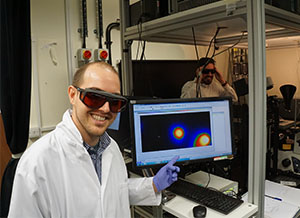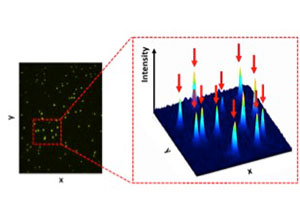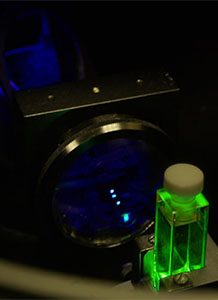The award of an Alzheimer's Research UK Fellowship
Posted on 1 October 2019

For decades, biophysical scientists were hindered by a major limitation: that nature’s nanoscopic biomolecules could not be detected during conventional optical microscopy experiments. This limitation was ingeniously circumvented by the 2014 Nobel Prize Winners in Chemistry who utilised light-emitting molecules to observe each biomolecule at work, one at a time. In turn, this enabled detailed investigations of their structure and function, and importantly how they interact with one another.

Leveraging these groundbreaking 'single-molecule microscopy techniques', Dr Steven Quinn at the School of Physics, Engineering and Technology has been awarded an Alzheimer’s Research UK Fellowship to track the behaviour of single proteins implicated in neurodegeneration, and how they interact with each other to form toxic nanostructures.
A major hallmark of Alzheimer’s disease includes the accumulation of these nanostructures into fragments which can puncture holes in the brain cell wall, leading to dysregulation and loss of vital cellular contents. One analogy behind the search for an effective drug is a flooded kitchen caused by a burst drain: drug discovery has focused on duct taping the drain, but without understanding and preventing the root cause.

In collaboration with Professor Mark Leake (Chair of the Physics of Life Research Group, School of Physics, Engineering and Technology and member of the Immunology, Haematology and Infection theme) and Dr Gareth Evans (Senior Lecturer, Department of Biology and member of the Neuroscience theme) he aims to combine major technological developments in single-molecule imaging with new biochemical techniques to unravel the molecular details of how these toxic nanostructures, at their earliest stage of assembly, confer toxicity.
This highly interdisciplinary research project will provide real-time readouts of Alzheimer’s pathology on the nanoscale, providing a platform for researchers to more effectively and efficiently search for the next generation of Alzheimer therapeutics.
Dr Quinn is a lecturer in Biophysics, specialising in multidisciplinary science across the life-sciences interface. His work combines recent advances in biochemistry with state-of-the-art microscopy tools to probe the molecular building blocks of human life and disease. He completed his PhD at the University of St Andrews (UK) and held research positions at the University of Glasgow (UK) and the Massachusetts Institute of Technology (MIT) (USA).
